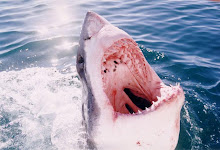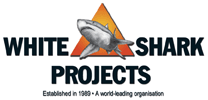FIN-ID CATALOGUE:
Over the last year consistent data has been collected on individual shark sightings. For the purposes of this document 4 individual sharks are included to show residency patterns and the periods for which some individuals remain around the Dyer Island area.
The information recorded within may not thoroughly represent the population dynamics of the species in this area. This information cannot be used to represent the population as a whole as there is a large amount of variability within the behavioural repertoire of each individual.
There are undoubtedly some individuals that will not be observed around cage diving vessels and there is no evidence to suggest that a single animal will continue to approach the boat with every successive sampling period. Some individuals may learn to avoid the vessel to due to the effects of negative conditioning and the lack of food rewards.
The 4 individuals appearing in this document have become well known over the last year and as a consequence have been named.
I have chosen these specimens to show other areas of research interests such as healing abilities, residency, growth rates and seasonal visitation.
Shark 1 – re-sights: Shark 2 – re-sights: Shark 3 – re-sights: Shark 4 – re-sights:
28/11/2008 28/04/2008 14/06/2007 15/12/2008
01/12/2008 10/10/2008 21/06/2007 18/12/2008
06/12/2008 03/06/2009 03/06/2009 21/12/2008
15/12/2008 22/06/2009 19/06/2009 26/12/2008
18/12/2008 01/07/2009 20/06/2009 29/12/2008
04/07/2009 02/07/2009 31/07/2009 11/02/2009
17/07/2009 03/07/2009 02/08/2009
18/07/2009 05/07/2009
21/07/2009 24/08/2009
30/07/2009 04/09/2009
04/09/2009
10/09/2009
Shark 1 - Kimbo:
Kimbo was originally observed at a size of 2.3 metres on the 28/11/2008. Our first observations were made in the summer grounds known as Joubert’s Dam. The right hand side of the dorsal has a ‘√’ shaped pigmentation blemish and the left hand side has a small heart shaped pigmentation blemish. Situated just anterior to the dorsal on the left hand side there was a large +/- 20 cm long, +/-3 cm deep cut. Over November and December we were able to track the healing of this cut which was astonishingly quick. Read more: Healing powers of the Great white shark. Kimbo had become very familiar with the cage diving vessel and appeared to learn and adapt her strategy over time. We are therefore recording all behaviours around the vessel to investigate cognition, memory and learning capabilities. Over the last year I believe Kimbo has grown into the offshore island population. She moved to the island from the inshore nursery ground and remained there till the end of the winter season into September 2009. It will be very interesting to see whether this particular individual moves back down into the nursery grounds for the summer. Since November 2008 this juvenile shark has increased in length by 20 cm.
Shark 2 - Nemo:
This particular individual was first identified in August 2007. Nemo is a juvenile female and was initially recorded at a total length of 2.2 metres, she has been a long term resident of the Dyer Island area.
There are a few young individuals that have remained in the area for extended periods of time (>9 months). Many of the sharks we see are highly transient remaining in the area for short periods of time (2-4 weeks), with many other animals that we do not identify satisfactorily.
This small shark had severe wounds to the dorsal fin causing it to curl over and eventually tear away leaving two thirds of the dorsal with fragmented tissue. Roughly 70% of the right hand pectoral fin is missing. It would appear that the pectoral fin was initially compressed downward. Other marks on the body suggest that she may have been caught in a net or line. The reason Nemo has shown such a large degree of residency could be a result of her injuries. Over the last year Nemo has increased in length by 30 cm and continues to surprise us that she has made it through another season, getting bigger and stronger every time she is observed. Nemo was observed on several occasions between August 2007 and October 2008, a period spanning both the summer and winter periods and locations. During our first trip to Joubert’s Dam, October 2008, Nemo made an appearance and then was not seen until June 2009. We do not know if Nemo remained in the local area or moved elsewhere along the coastline.
Shark 3 - Slash-fin:
This 3.5metre male has been a long term winter visitor to Dyer Island, arriving right in the peak season for predatory activity (June, July & August) and leaving shortly after. Slash-fin is aptly named due to the 3 large gashes that run through the dorsal fin. Initially the fin was severely damaged with the pieces moving independent of each other. Over time the dorsal fin has fused back together. Slash-fin was originally named and spotted in 2004. This male has returned to the island every winter since. Although white sharks are not considered to be territorial, Slash-fin is only usually observed at a location called South of Geyser. It is very unusual to observe him around other areas of the reef system during his brief visits unless it is when he initially arrives at Dyer Island.
Shark 4 - Gash:
Gash was originally sighted in Joubert’s Dam throughout December. When we first observed this small 2.5 metre female there was a huge gaping wound on the dorsal surface just anterior to the dorsal fin. It appears this wound was most likely caused by a boat propeller. Gash and Kimbo have given us the opportunity to try and establish how fast white sharks are capable of healing after severe trauma. We did not encounter Gash in January and only caught a brief glimpse of her on one trip on the 11/02/2009. This allowed us to gauge how well her wounds had healed throughout this period. The results were astonishing with her showing a very rapid rate of tissue recovery and mobility. It is unclear whether this particular individual had remained in the area throughout January or left the area and returned. There were reports of her by other vessels. This is a clear limitation of the dorsal fin identification catalogue as a method to continually track the localised movement patterns of sharks in the area.
Conclusion:
The population composition of this area is very complex. There appears to be two distinct seasonal grounds, the South African summer and winter compositions. The composition during summer typically consists of large (4.0 metre) females and juveniles (1.2-2.5 metres), males and intermediate (2.5-4.0 metres) size classes are usually absent or rare. During the winter season the shark’s frequent Dyer and Geyser islands for the purposes of hunting the seasonal abundance of Cape fur seals. Males and females are observed in equal proportions and intermediate size classes (2.5-4.0 metres) are usually common.
Sharks that are approaching adulthood may navigate South Africa’s coastline and stop at these off shore islands for short periods of time to take advantage of the abundance of food. They do not appear to stay for long periods of time, usually <1 month. It could be that once they have exhausted the food resources in a particular area they move elsewhere to hunt. Whilst they are hunting I believe that some individuals such as Slash-fin are semi-territorial, having preferred hunting locations and drop off points along known seal run-ways. The younger animals appear to float between hunting sites and don’t appear to hold territories for any sort of consistent time period.
Nemo and Kimbo were summer sharks, observed down in the shallows in the nursery ground area. Both sharks would later be present at the island in the winter suggesting potential recruitment into a more transient population with a highly migratory mode of lifestyle. We will have to wait and see if any of these animals show up in the summer grounds this season.
To follow these sharks, visit our website: www.whitesharkprojects.co.za
Subscribe to:
Post Comments (Atom)






No comments:
Post a Comment